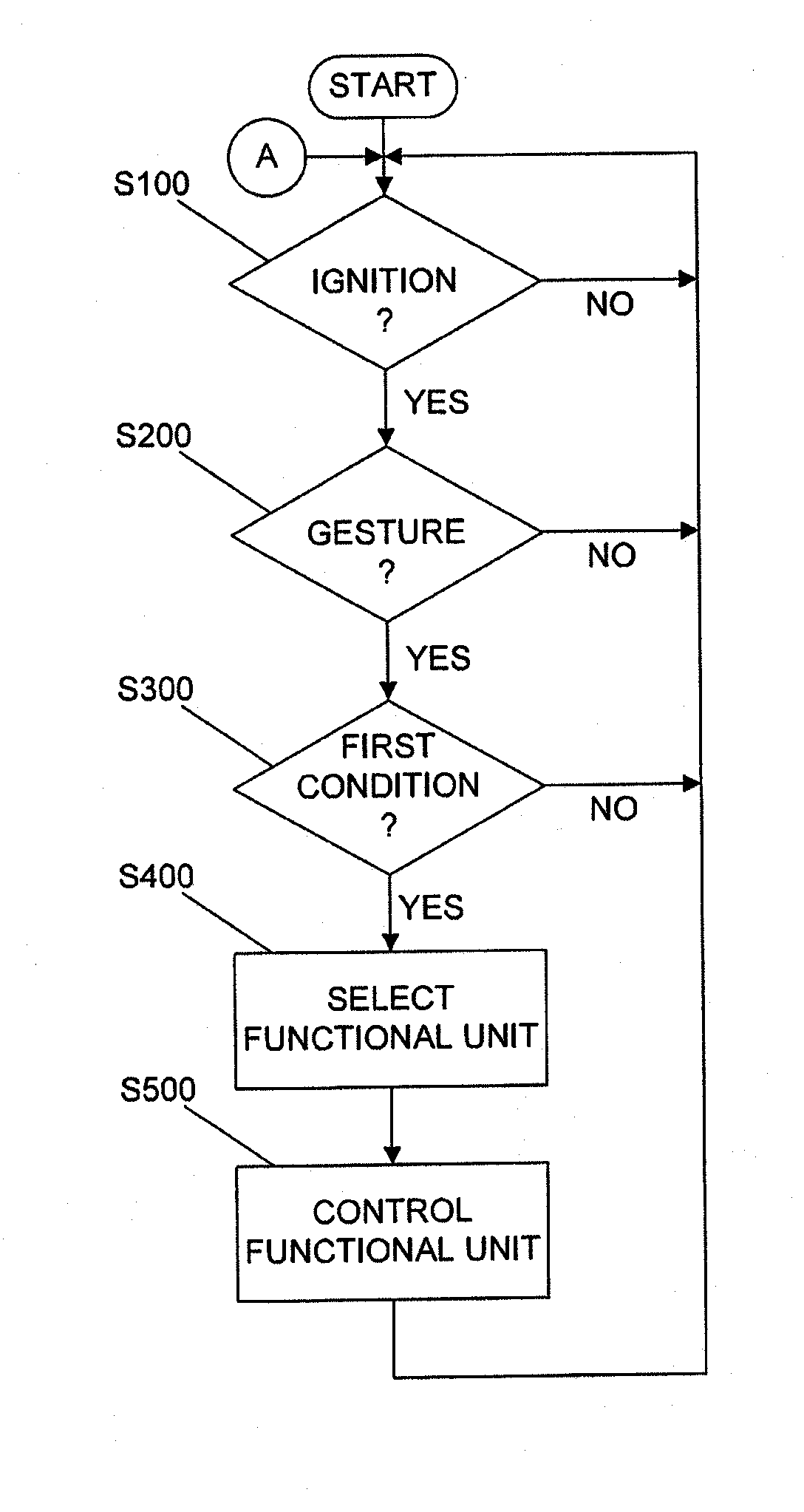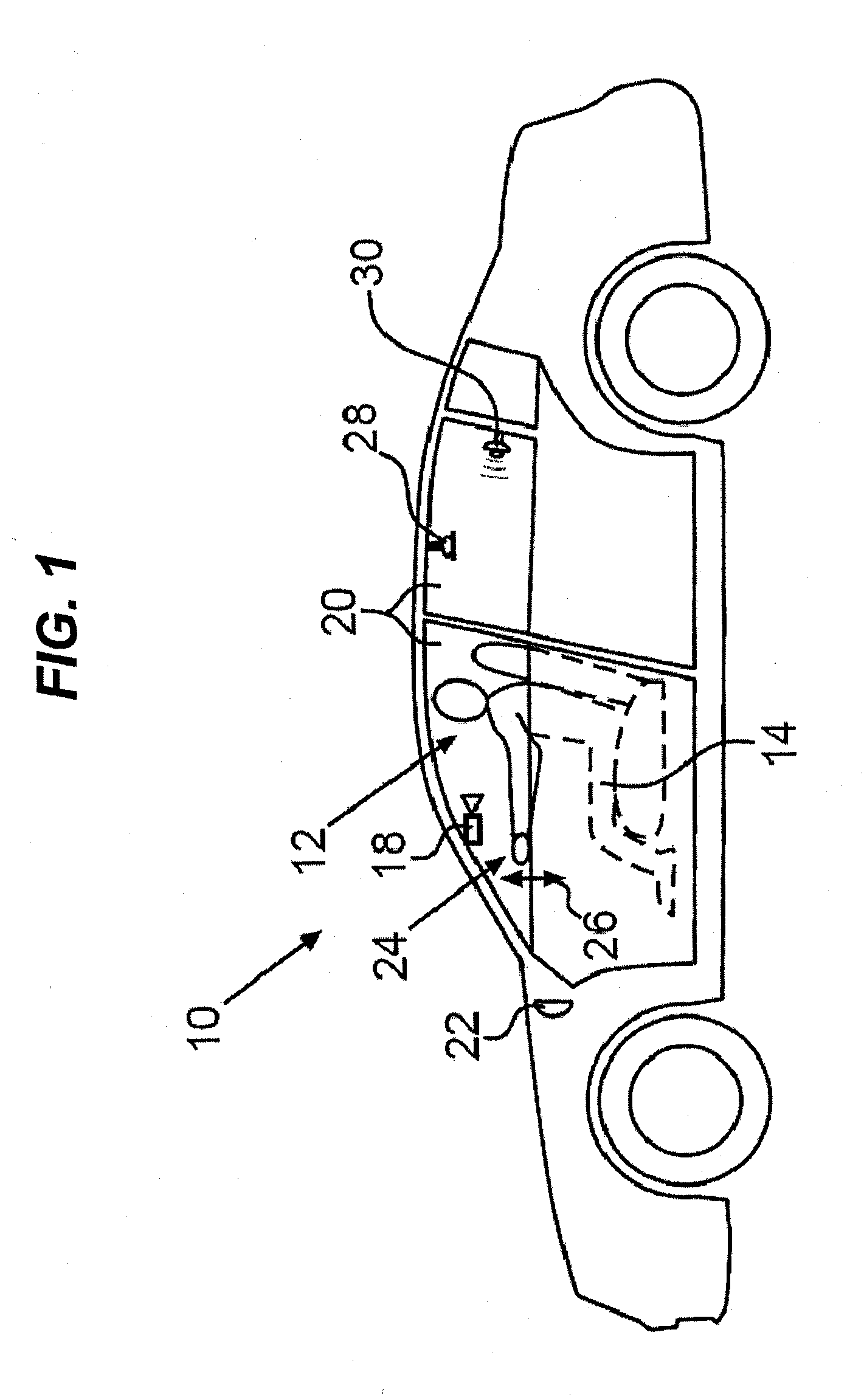Method, Device and Computer Program Product for Controlling a Functional Unit of a Vehicle
a technology of a vehicle and a functional unit, applied in the direction of vehicle position/course/altitude control, process and machine control, instruments, etc., can solve the problems of large cost for the vehicle manufacturer, predetermined gestures, memorizing, etc., and achieve the effect of improving gesture recognition and increasing accuracy
- Summary
- Abstract
- Description
- Claims
- Application Information
AI Technical Summary
Benefits of technology
Problems solved by technology
Method used
Image
Examples
first embodiment
[0032]Hereinafter, a description of the present invention is given.
[0033]FIG. 2 shows a flow chart of a process flow according to the first embodiment of the present invention.
[0034]At a step S100, a check is made as to whether or not ignition of the vehicle 10 has been switched on. If the decision at step S100 is NO, then the process flow returns to step S100.
[0035]If the decision at step S100 is YES, then the process proceeds to a step S200, in which it is checked whether or not a gesture has been made by the vehicle passenger 14. If the decision at step S200 is NO, then the process returns to step S200.
[0036]If the decision at step S200 is YES, then the process flow proceeds to step S300. At step S300, it is checked whether or not the gesture made by the vehicle passenger 14 fulfills a first predetermined condition. In more detail, the first predetermined condition is fulfilled if the gesture made by the vehicle passenger 14 has a movement sequence that coincides with a movement ...
second embodiment
[0045]Hereinafter, a description of the present invention is given.
[0046]FIG. 3 shows a flow chart of a method sequence according to the second embodiment of the present invention.
[0047]It should be noted that the second embodiment of the present invention, with the exception of the changes regarding assembly and functional principle described below, is the same as the first embodiment of the present invention described above, and so redundant description is omitted.
[0048]As is shown in FIG. 3, the process flow has, in addition to the process flow shown in FIG. 2, a step S150 that is carried out between step S100 and step S200.
[0049]At step S150 a check is made as to whether alignment of a head of the vehicle passenger 14 and / or direction of gaze of eyes of the vehicle passenger 14 is in the direction of, for example, one or several functional units. If the decision at step S150 is NO, then the process returns to step S100. If the process flow at step S100 is YES, then the process f...
third embodiment
[0052]Hereinafter, a description of the present invention is given.
[0053]FIG. 4 shows a flow chart of a process flow according to the third embodiment of the present invention.
[0054]It should be noted that the third embodiment of the present invention has additions compared to both the first and second embodiments of the present invention and, with exception of the additions and / or changes described below regarding assembly and functional principle, it is the same as that of the first or second embodiments of the present invention described above, and so redundant description is omitted.
[0055]In more detail, a corresponding functional unit can additionally be selected by a speech signal from the vehicle passenger 14. This speech signal can be identified, for example, by the microphone 28 located in the passenger compartment 12 of the vehicle 10. Controlling or setting a functional unit can likewise be stopped or reversed by an appropriate speech signal. To this end, corresponding wo...
PUM
 Login to View More
Login to View More Abstract
Description
Claims
Application Information
 Login to View More
Login to View More - R&D
- Intellectual Property
- Life Sciences
- Materials
- Tech Scout
- Unparalleled Data Quality
- Higher Quality Content
- 60% Fewer Hallucinations
Browse by: Latest US Patents, China's latest patents, Technical Efficacy Thesaurus, Application Domain, Technology Topic, Popular Technical Reports.
© 2025 PatSnap. All rights reserved.Legal|Privacy policy|Modern Slavery Act Transparency Statement|Sitemap|About US| Contact US: help@patsnap.com



